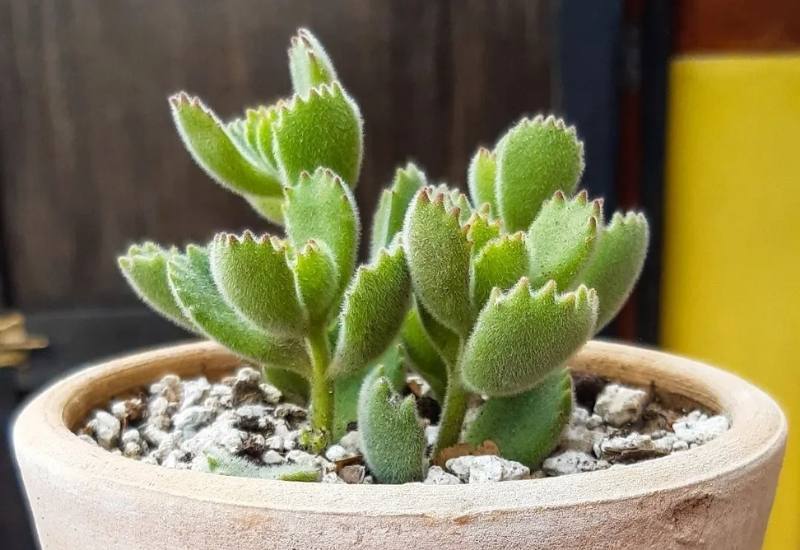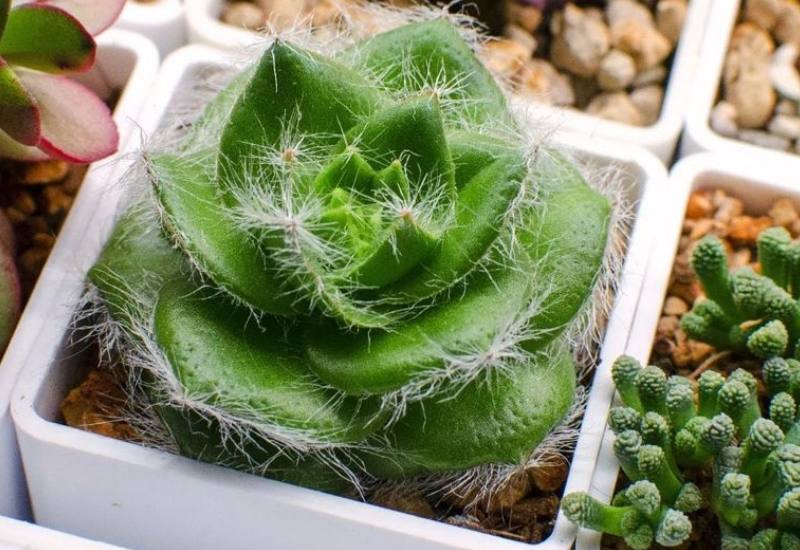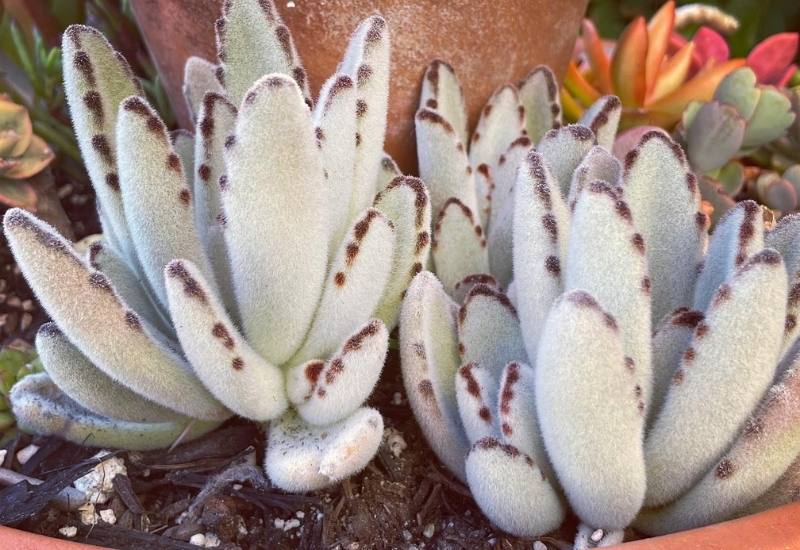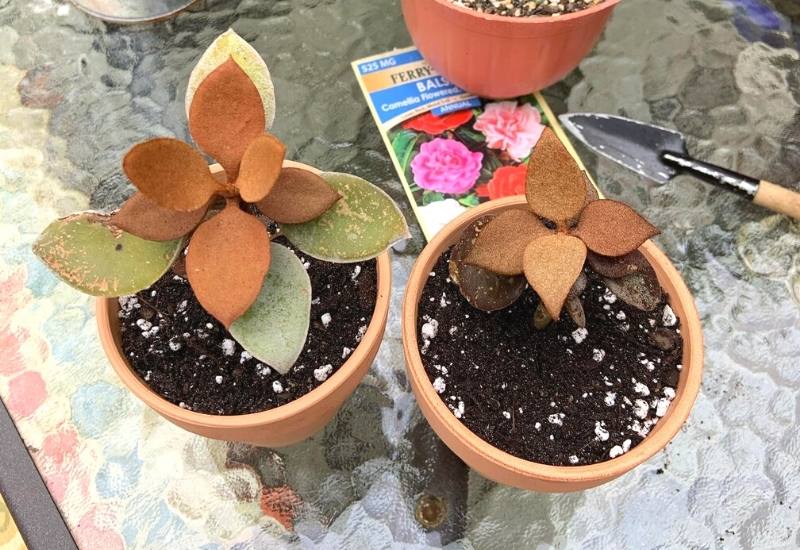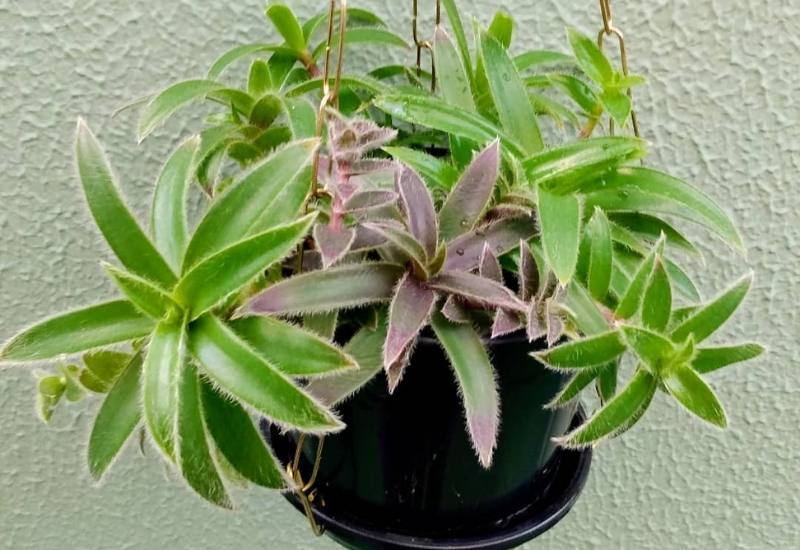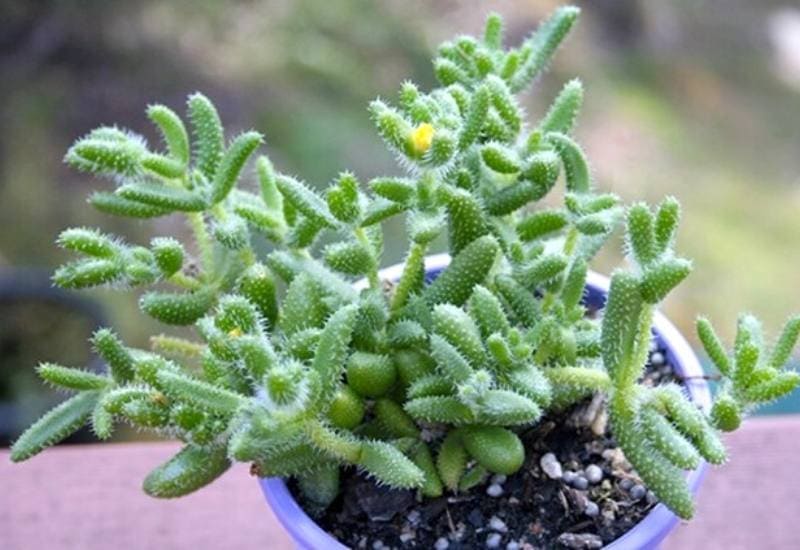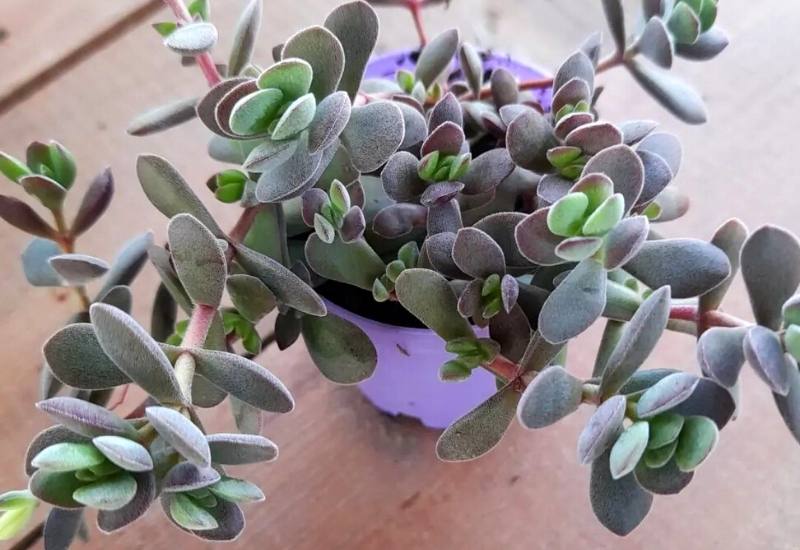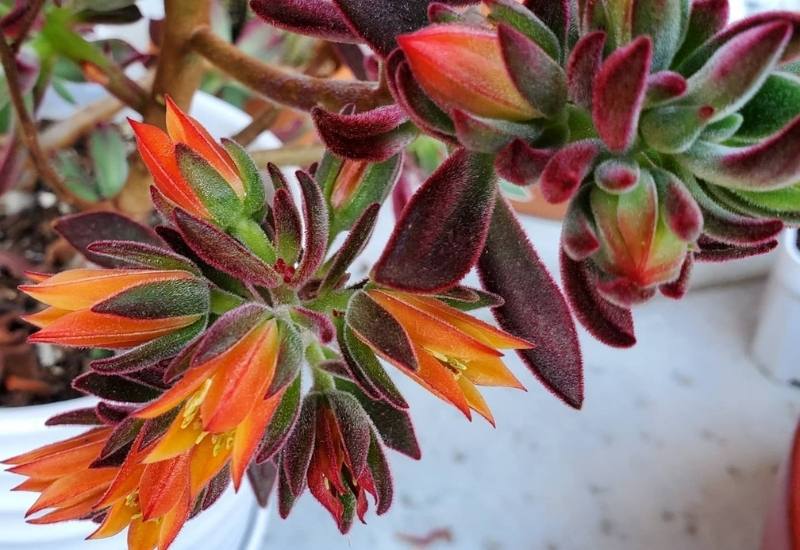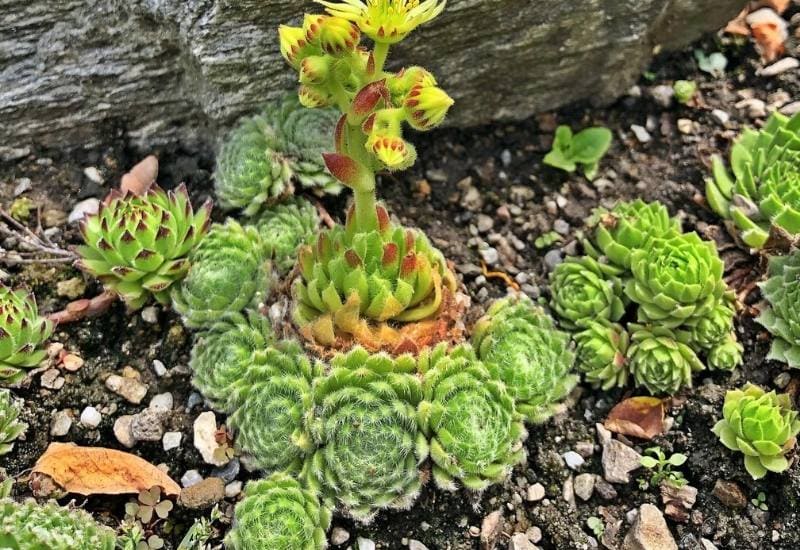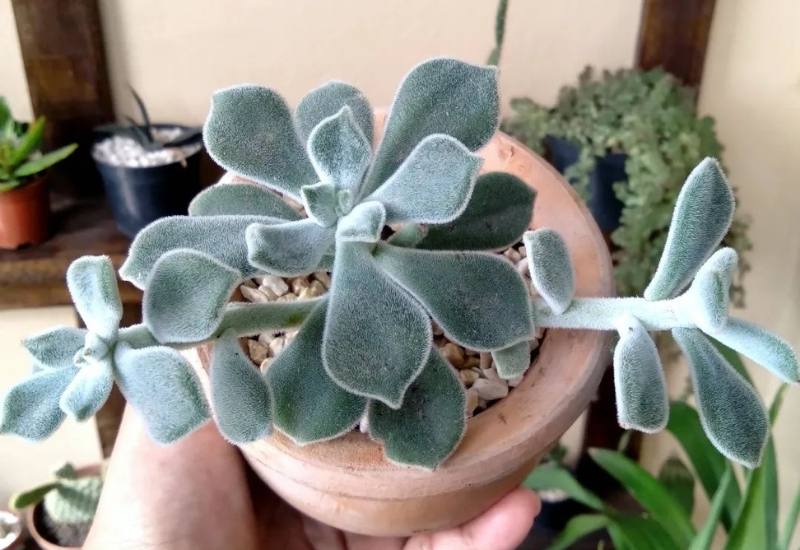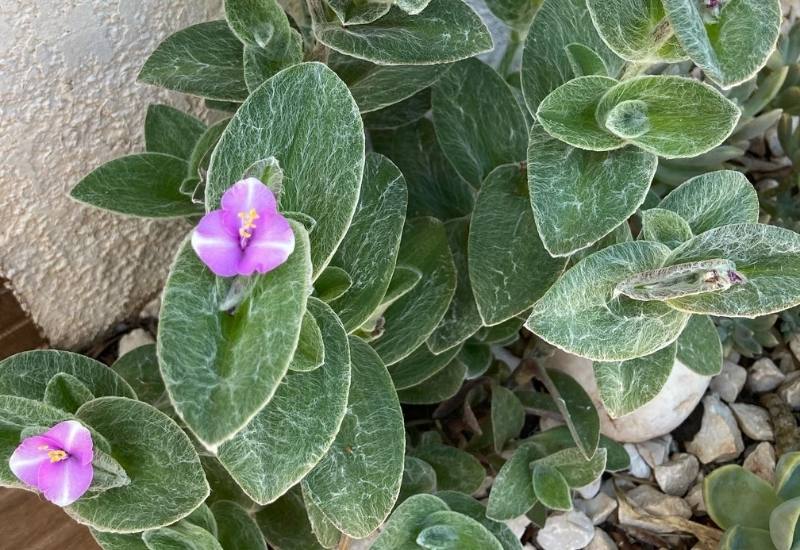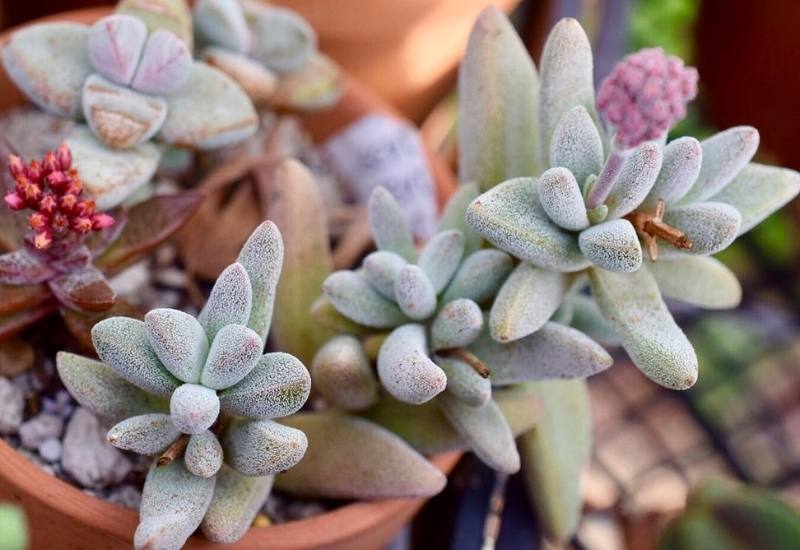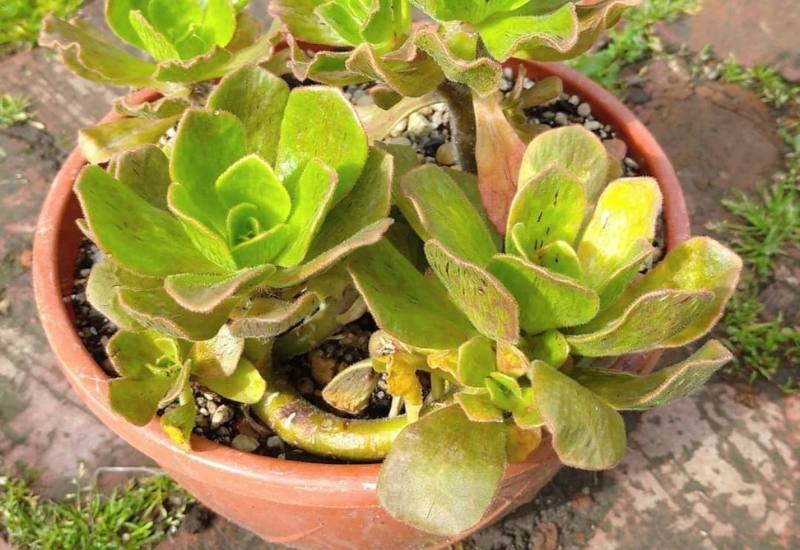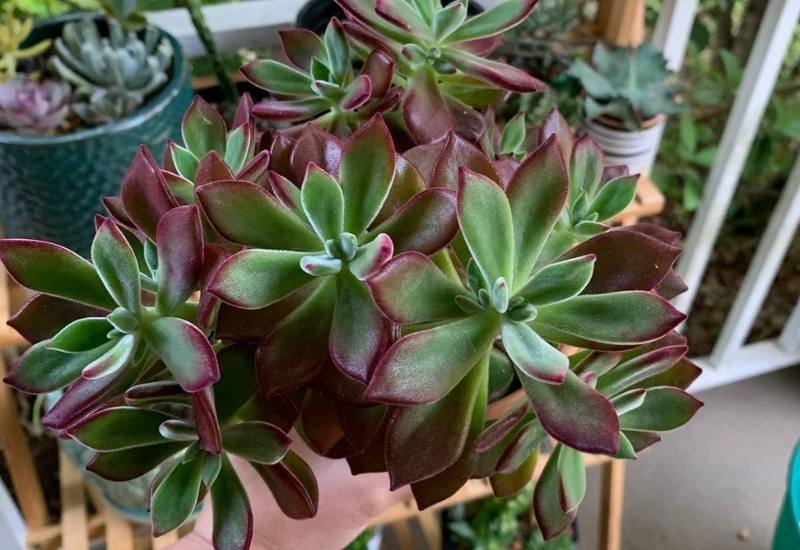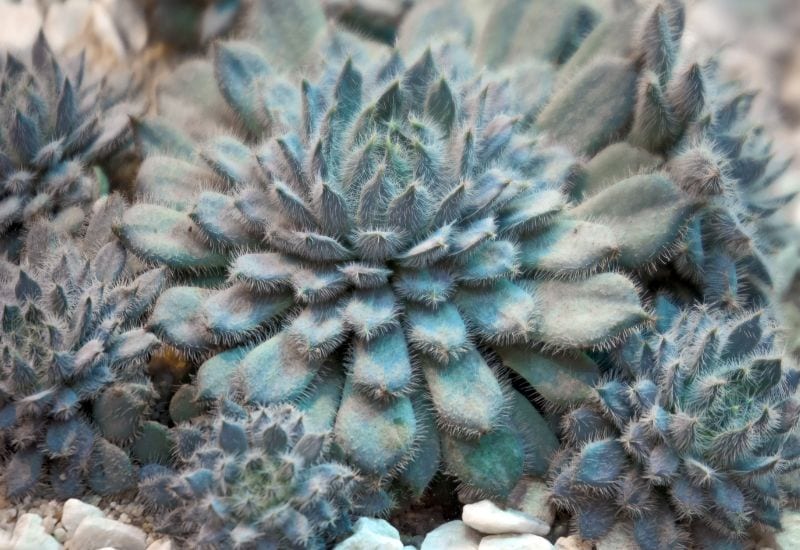
Soft looking, velvety fluffy and on top of this plump and originally shaped: I am talking about fuzzy succulents coming from harsh, dry regions all over the world to your living room or garden.
From bear’s paws to prickle plant, they share one unusual trait: they have trichomes, or “plant hairs as a mechanism to support survival.…
Strange, because you don’t expect a plant to need a coat in desert, but they don’t use it to warm themselves up, on the contrary, to protect themselves from excessive heat and sunlight!
But apart from this, they all differ: shapes, colors, sizes and blooms of these fuzzy leaf succulent varieties are an explosion of creativity, which you too can have, if you keep reading on!
Even the names are evocative and fluffy! I will show you how beautiful they are in a second, but first, have you ever wondered why some succulents have hairs and fluff?
Why Some Succulents Have Fuzzy Leaves
The fluff on plants, not just on succulents, has a technical name, trichomes, and it has a reason, a function as well. They protect the plant from harsh environmental conditions, and they are very specialized.
In fact, there are at least 8 different types of trichomes, and they can have functions like:
We can say that in general, they are a defense system, either against climate conditions or hungry animals…
But do we need to treat hairy succulents differently from others?
Care Tips For Growing Fluffy Succulents
Succulents are easy to care, and fluffy are not an exception, but, you need to avoid dropping water on the leaves, especially when the Sun is high and strong.
Usually, this is not an issue with succulent plants; the water just slides off. But when they have hairs, the droplets can get caught in them and function like a lens, burning the plant’s tissue.
On the other hand, this means that your fluffy succulent is very resistant to drought. For all the rest, follow regular succulent guidelines (especially with soil drainage and watering).
And in case it gets dirty…
How to Clean a Dirty Fuzzy Succulent
Hairs in the leaves of succulents can catch and hold dirt, and what can you do if you cannot wash it? Simple, use a soft paint brush and delicately stroke the plant. Just make sure that your brush is clean and dry beforehand.
15 Adorable Succulents with Fuzzy, Velvety Leaves
And now, let’s get going with the selection of succulents whose fuzzy and woolly leaves just beg to be touched. Ready for the softest, fluffiest succulents ever? So, here are 15 cute fuzzy leaf succulent species to bring a bit of sophistication to your home.
1: Bear’s Paw (Cotyledon tomentosa)
Playful, child friendly and evocative, bear’s paw is one of the world’s favorite fluffy succulents. It forms small shrubs with a dense plump foliage and… The leaves look literally like the paws of animals, with little triangular “claws” at the top end of the leaves.
And while the main color is bright green, these final tips are dark purple brown, making the visual effect far more noticeable. Of course, these are also covered in a thin and soft layer of hairs.
It also blooms, unlike bears, and the flowers are quite pretty indeed: star shaped and with five long and pointed petals, they have lovely shades of yellow and pink orange, sometimes purple, with a vague hint of lime green as well.
Bear’s paw is like a living teddy; if you have children, or if you have a child within you, you really cannot do without it!
2: Bearded Leaved Crassula (Crassula barbata)
Coming from South Africa, this sweet looking, hairy beauty, bearded leaved crassula, is usually grown as an annual outdoors, but you will love it even indoors.
It usually has only one, small rosette, but sometimes you can get two or three. When young, the pointed and heart shaped leaves are quite decorative, bright green and with a white, icy fluff of white hairs all around the margins which can be more or less dense, but the light effects are always beautiful.
Ad they grow, they change shape and the whole plant looks like a rose. The bloom comes at the end of this succulent’s life, with a long spike of densely packed white or pink flowers.
Bearded leaf crassula is not a very common succulent, despite its lovely fluff; but if you find it, it will set your collection apart from that of your neighbors.
3: Panda Plant (Kalanchoe tomentosa)
Panda plant is a soft looking succulent with a thin coat that makes it look fluffy like a cushion.
The long and broad, roughly elliptical foliage is bluish green and the margins are decorated with brown spots. Each can reach about 3.2 inches long (8.0 cm).
Erect as a habit, it forms lovely clumps of cuddly looking plump little “paws”. It is also happy to bloom once a year on long stems that reach above the rest, and the flowers are small but very pretty, in shades of green, yellow brown or purple; as often happens with succulents, flower color can be a surprise, but always bright! It is also a winner of the Award of Garden Merit by the Royal Horticultural Society.
Easy to grow indoors, panda plant can also grace rock and gravel gardens or flower beds, as long as you live in a hot and sunny region, otherwise you can use containers and shelter it during winter.
4: Mexican Firecracker (Echeveria setosa)
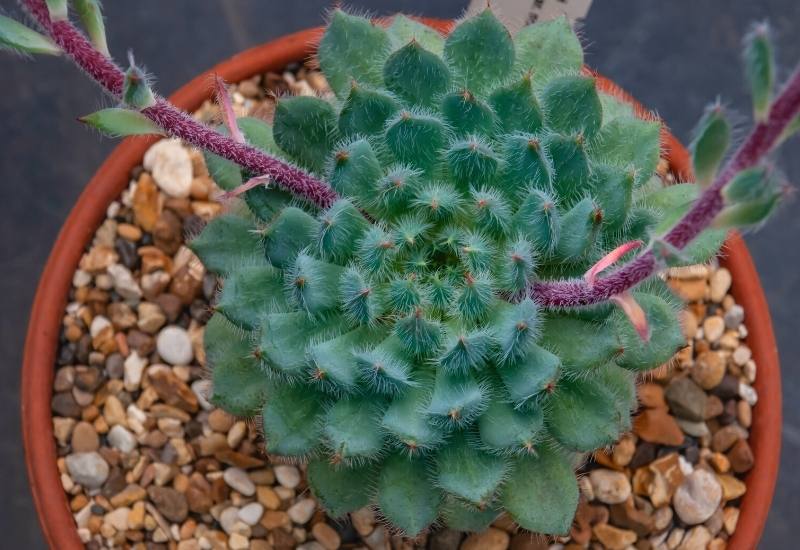
Mexican firecracker tales its name from the Latin word for bristles, which adorn its lovely rosettes. Very pronounced on the margins, they also catch dew in the morning, but what matters to us is that they make it look very hairy indeed!
Light green with a white coating, therefore, this succulent looks very fresh and artistic at the same time.
Depending on light and climate conditions, the tips can become red as well. Flowers appear on very long stalks, about 1 foot (30 cm), and they are orange red but with yellow tips.
Coming from semi desert areas of Mexico, this echeveria has a great value for indoor décor as well as rock gardens.
5: Copper Spoons (Kalanchoe orgyalis ‘Copper Spoons’)
Add a thin, velvet looking fluff to a very impressive color and you get copper spoons. It os a lush, luxurious looking plant, with broad, almost heart shaped pointed leaves have the most impressive copper color ever; this is by far the most striking feature of this small succulent.
Some may be light green and this adds a lovely harmonic contrast. They grow on thin branches and in combination with their texture, they really work well as a centerpiece, like a little living statue.
Long lasting yellow blooms will appear in terminal clusters on the tips of this very unusual plant from Madagascar.
Copper spoons is mainly an indoor fuzzy succulent; its high decorative value makes it very, very sought after, but it is easy to propagate by stem cuttings.
6: Pussy Ears (Cyanotis somaliensis)
Like with many fluffy succulents, the evocative name really describes pussy ears well. Forming clumps of long, horse ear like foliage on short stems, the bristly hair that grows on their margins suggest the hearing organs of an animals, in fact…
And these can have a lovely range of colors, from pale green, to light blue to purple! However, this depends on the light, so, you can still enjoy it if it is mid green.
The flowers are small and mauve in color, but the stems are quite big and, surprisingly, golden!
Coming from Somalia, this unusual fluffy succulent is an easy to grow houseplant; it is not easy to get by, but if you do, propagate it by stem cutting and gift it to your friends and neighbors.
7: Pickle Plant (Delosperma echinatum)
With soft but spiny looking hairs, prickle plant is a playful little succulents with an unruly but enchanting look. The many little plump, oval green leaves that have white trichomes that may remind you of the beard of adolescents, but they are white…
With a draping habit, these will also host among them canary yellow flowers with many long and thin petals, like delicate dandelions, about 0.8 inches across (2.0 cm). This shrubby companion comes from South Africa to your garden, or even as a houseplant.
Prickle plant is perfect for rock gardens and containers, or as ground cover, thanks to its draping branches. It adds a hirsute touch, a flavor of the wilderness, though on a small scale, and it is fairly cold hardy too!
8: Crassula Lanuginosa (Crassula lanuginosa)
Crassula lanuginosa does not have a common name, but to give you the idea, in Latin it means “woolly”; and this says it all. This small prostrate succulent from South Africa forms a soft looking mat with its tightly packed pointed, almost triangular leaves covered in a short down.
These form rosettes at the end of the stems they hide so well… They are gray green in color, which goes perfectly well with the delicate looking cream white flowers that appear in flat topped clusters (technically called “thyrses”).
If you want a colorful variant, the cultivar ‘David’ has bright white and magenta top leaves as well!
Perfect for rock gardens or as ground cover, Carassula lanuginosa softens edges and slopes with its fluffy foliage, and it is also very easy to propagate by stem cuttings.
9: Ruby Slippers (Echeveria harmsii ‘Ruby Slippers’)
Once more, a name that describes our hairy succulent perfectly well: ruby slippers. This cultivar in fact has leaves that look like comfortable, warm household footwear, or rabbit ears if you prefer.
This is because the velvety fluff on the foliage softens the already well fused palette of bright ruby red purple and bright green that it displays. Forming lovely rounded clumps, on the whole it may even remind you of a cushion…
The flowers are very pretty too: bright orange and bell shaped, and hovering above this shrubby plant.
Perfect as a houseplant, ruby slippers can adapt to outdoor settings, but you need to live in a warm country and keep an eye on it; the color may change with the climate and seasons.
10: Teneriffe Houseleek (Sempervivum ciliosum)
Teneriffe houseleek grows lots of rosettes that spread sideways, with their regularly arranged, pointed succulent leaves covered in what looks like a spider web! In fact the hairs literally form a silver white veil that covers the plant, like a protective screen.
The foliage is pale green with some light lavender blushes or purple patches at the tips. These will start off looking like flower buds and then partly open as the plant matures.
Clusters of greenish yellow flowers will tower above it on thick and tall stems that reach about 4 inches in height (10 cm).
Teneriffe houseleek is your perfect choice for an outdoor rock garden or containers in temperate, even cool regions, as it is quite cold hardy as well; it propagates naturally with pups.
11: ‘Frosty’ White Chenille Plant (Echeveria pulvinata var. frigida)
White chenille plant is covered in a velvety layer of fine hairs, that make it look like the soft and swishy material in the name it bears…
The upright branches have spoon shaped leaves that are actually mid green, but the white fuzz makes them appear almost gray blue in color.
It needs lots of light to look its best, also because the effects on the foliage are glistening and very interesting. It will also bear beautiful pink purple blooms once a year.
White chenille can be used to soften compositions in rock or dry gardens, but also as an indoor plant, it can bring a soft but sparkling look to indoor spaces.
12: White Velvet (Tradescantia sillamontana)
Also known as cobweb spiderwort or white gossamer plant, white velvet is a variegated Tradescantia variety with cream and green foliage covered in a layer of white hair that reminds you of the work of arachnids.
With lengthways stripes, the alternate leaves open from the bottom of the arching, even trailing soft branches way up to the tips. And there is where you will also find the iconic blooms of this genus…
With three petals and an overall triangular shape, these are bright pink magenta with white lines that go from the tips of the petals to the center.
You can grow white velvet in rock gardens, in containers and even as ground cover; it is a very healthy plant; do not worry if the branches break every now and then, they are brittle but they grow back in a short time.
13: Namaqua Crassula (Crassula namaquensis)
Namaqua crassula combines a fluffy look with original sculptural value. In fact, the plump, candy shaped pointed leaves are covered in a thin and short white fuzz that gives them a very mellow appearance.
But their shape and the fact that they are arranged in a spiraling order along the hidden stems makes it look like a modern and very elegant little sculpture.
The color is pale green, but thanks to the light effect cause dry the trichomes, you will think that the whole plant is ice blue!
Well, not the whole, because a lovely pink stem will rise from the little clumps and bear creamy white flowers!
Namaqua crassula looks great in a decorative pot, and if you add some gravel with a well chosen color, you can heighten the elegant and refined display of this little wonder from Namibia and South Africa.
Tips
14: Smith’s Giant Houseleek (Aeonium smithii)
Smith’s giant houseleek has qualities that most other fluffy succulents lack. To start with it is fairly large, while most are small, forming sizable shrubs.
Next, the leaves match two apparently contrasting qualities: they are both very glossy, smooth and waxy, and hairy at the same time.
The green leaves also have raised drops of purple on them, a shade which they take up at the very tips and edges as well. Even the blooms are large and showy, about 1 inch across and bright yellow!
Smith’s giant houseleek is great for a dry, desert garden, or a gravel yard or rock garden; it can even work well in beds and borders, adding a very original touch and lush foliage.
15: ‘Devotion’ Echeveria (Echeveria pulvinata ‘Devotion’)
You won’t get flowers with ‘Devotion’ echeveria, but the fuzzy rosettes make up for it ten time more! With pointed, succulent and gently curving leaves, these form almost spherical compositions with a very soft texture, like velvet, because the trichomes are very short, transparent and tightly woven on their surface.
These are bright green in color, but expose them to strong light and they will develop eye catching dark ruby red tips!
This way, even if this cultivar does not blossom, it will be like having large blooms all year round!
‘Devotion’ echeveria needs more fertilizer than other succulents, about 4 times; it is not a sturdy variety, and for this reason, it is only a houseplant, but a very luxurious one at that!
Fluffy And Unusual Succulents
This is the end of our soft, fluffy journey among hairy succulents. There are quite a few varieties, all different, with many colors and bright blooms, but they all add a touch of soft velvety texture to gardens and indoor spaces, that “soft feel” we all love!

Written By
Amber Noyes
Amber Noyes was born and raised in a suburban California town, San Mateo. She holds a master’s degree in horticulture from the University of California as well as a BS in Biology from the University of San Francisco. With experience working on an organic farm, water conservation research, farmers’ markets, and plant nursery, she understands what makes plants thrive and how we can better understand the connection between microclimate and plant health. When she’s not on the land, Amber loves informing people of new ideas/things related to gardening, especially organic gardening, houseplants, and growing plants in a small space.

